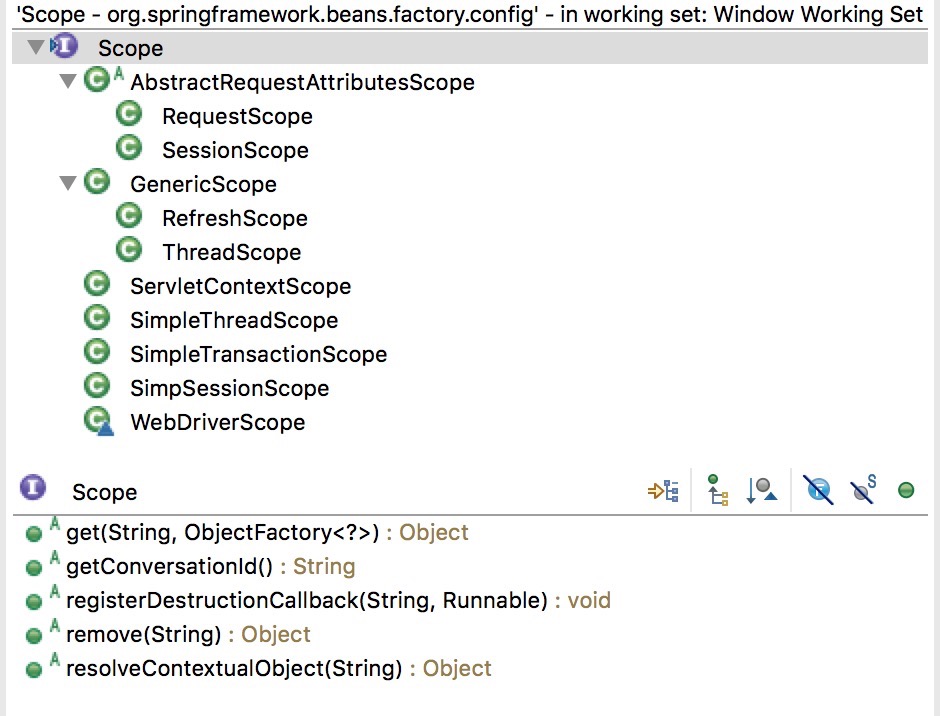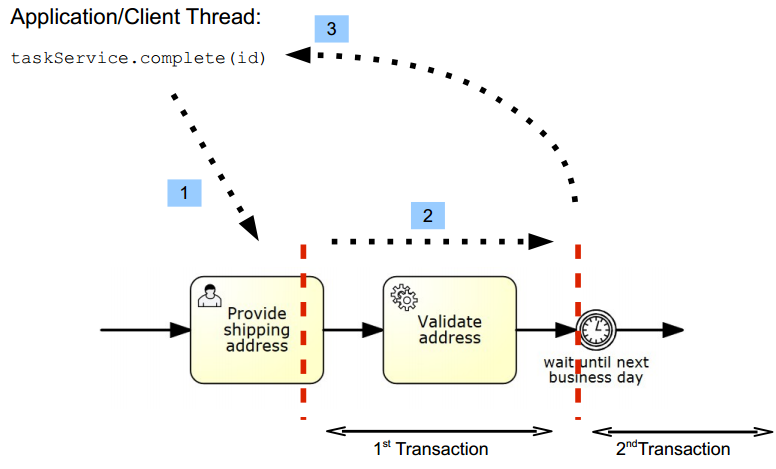- RefreshScope注册
- RefreshAutoConfiguration#RefreshScopeConfiguration
@Component
@ConditionalOnMissingBean(RefreshScope.class)
protected static class RefreshScopeConfiguration implements BeanDefinitionRegistryPostProcessor{
...
registry.registerBeanDefinition("refreshScope",
BeanDefinitionBuilder.genericBeanDefinition(RefreshScope.class)
.setRole(BeanDefinition.ROLE_INFRASTRUCTURE)
.getBeanDefinition());
...
}
- RefreshScope extends GenericScope, 大部分逻辑在 GenericScope 中
- GenericScope#postProcessBeanFactory 中向AbstractBeanFactory注册自己
public class GenericScope implements Scope, BeanFactoryPostProcessor...{
@Override
public void postProcessBeanFactory(ConfigurableListableBeanFactory beanFactory)
throws BeansException {
beanFactory.registerScope(this.name/*refresh*/, this/*RefreshScope*/);
...
}
}
- RefreshScope 刷新过程
- 入口在ContextRefresher#refresh
refresh() {
Map<String, Object> before = ①extract(
this.context.getEnvironment().getPropertySources());
②addConfigFilesToEnvironment();
Set<String> keys = ④changes(before,
③extract(this.context.getEnvironment().getPropertySources())).keySet();
this.context.⑤publishEvent(new EnvironmentChangeEvent(keys));
this.scope.⑥refreshAll();
}
- ①提取标准参数(SYSTEM,JNDI,SERVLET)之外所有参数变量
- ②把原来的Environment里的参数放到一个新建的Spring Context容器下重新加载,完事之后关闭新容器
- ③提起更新过的参数(排除标准参数)
- ④比较出变更项
- ⑤发布环境变更事件,接收:EnvironmentChangeListener/LoggingRebinder
- ⑥RefreshScope用新的环境参数重新生成Bean
- 重新生成的过程很简单,清除refreshscope缓存幷销毁Bean,下次就会重新从BeanFactory获取一个新的实例(该实例使用新的配置)
- RefreshScope#refreshAll
public void refreshAll() {
<b>super.destroy();</b>
this.context.publishEvent(new RefreshScopeRefreshedEvent());
}
public void destroy() {
...
Collection<BeanLifecycleWrapper> wrappers = <b>this.cache.clear()</b>;
for (BeanLifecycleWrapper wrapper : wrappers) {
<b>wrapper.destroy();</b>
}
}
- Spring Cloud Bus 如何触发 Refresh
- BusAutoConfiguration#BusRefreshConfiguration 发布一个RefreshBusEndpoint
@Configuration
@ConditionalOnClass({ Endpoint.class, RefreshScope.class })
protected static class BusRefreshConfiguration {
@Configuration
@ConditionalOnBean(ContextRefresher.class)
@ConditionalOnProperty(value = "endpoints.spring.cloud.bus.refresh.enabled", matchIfMissing = true)
protected static class BusRefreshEndpointConfiguration {
@Bean
public RefreshBusEndpoint refreshBusEndpoint(ApplicationContext context,
BusProperties bus) {
return new RefreshBusEndpoint(context, bus.getId());
}
}
}
- RefreshBusEndpoint 会从http端口触发广播RefreshRemoteApplicationEvent事件
@Endpoint(id = "bus-refresh")
public class RefreshBusEndpoint extends AbstractBusEndpoint {
public void busRefresh() {
publish(new RefreshRemoteApplicationEvent(this, getInstanceId(), null));
}
}
- BusAutoConfiguration#refreshListener 负责接收事件(所有配置bus的节点)
@Bean
@ConditionalOnProperty(value = "spring.cloud.bus.refresh.enabled", matchIfMissing = true)
@ConditionalOnBean(ContextRefresher.class)
public RefreshListener refreshListener(ContextRefresher contextRefresher) {
return new RefreshListener(contextRefresher);
}
- RefreshListener#onApplicationEvent 触发 ContextRefresher
public void onApplicationEvent(RefreshRemoteApplicationEvent event) {
Set<String> keys = contextRefresher.refresh();
}
- 大部分需要更新的服务需要打上@RefreshScope, EurekaClient是如何配置更新的
- EurekaClientAutoConfiguration#RefreshableEurekaClientConfiguration
@Configuration
@ConditionalOnRefreshScope
protected static class RefreshableEurekaClientConfiguration{
@Bean
@RefreshScope
public EurekaClient eurekaClient(...) {
return new CloudEurekaClient(manager, config, this.optionalArgs,
this.context);
}
@Bean
@RefreshScope
public ApplicationInfoManager eurekaApplicationInfoManager(...) {
...
return new ApplicationInfoManager(config, instanceInfo);
}
}
 scope_hierarchy.jpeg
scope_hierarchy.jpeg 架构C
架构C



